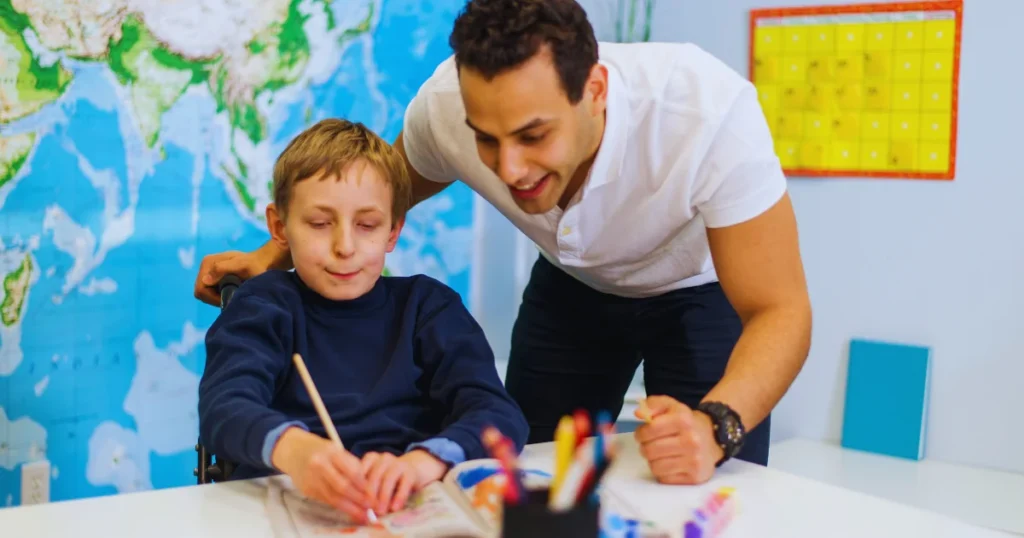Autism Spectrum Disorder (ASD) or autism and learning disabilities aren’t the same. Autism mainly affects social interactions and communication, while learning disabilities impact specific academic skills such as reading or math.
Understanding the difference between autism and learning disabilities helps provide the right support and care for individuals facing these challenges.
Table of Contents
Understanding Autism and Learning Disabilities
Is Autism a Learning Disability?
Many people often wonder if autism is a learning disability. It’s NOT—autism is classified as a neurodevelopmental disorder, not a learning disability. Autism affects how individuals communicate, interact, and process sensory information. It can also influence learning, often impacting social skills, language, and executive functioning.
However, it does not directly impair specific academic abilities like learning disabilities do, such as reading or maths. Autism and learning disabilities can co-exist, and understanding this distinction is vital for providing appropriate education and support.
What Is a Learning Disability?
A learning disability is a neurological condition affecting how someone receives, processes, and retains information. It does not reflect a person’s intelligence or motivation but rather influences specific academic skills, such as reading (dyslexia), mathematics (dyscalculia), motor skills or coordination (Dyspraxia) and writing (dysgraphia).
These challenges can impact schoolwork, daily skills, and even employment opportunities.
Unlike autism, which is more related to social and communication aspects, learning disabilities mainly hinder learning processes related to understanding concepts and academic tasks. Recognising the difference helps in creating personalised educational strategies that cater to each individual’s needs effectively.
How Do the Symptoms of ASD and LD Overlap?
Autism Spectrum Disorder (ASD) and learning disabilities (LD) share some overlapping symptoms, which often lead to confusion. These conditions are both lifelong and can significantly affect everyday life.
However, autism mainly influences social interaction, while learning disabilities impact academic abilities.

Shared Symptoms of Autism and Learning Disabilities:
- Social Difficulties: Struggles in understanding non-verbal cues or participating in conversations.
- Emotional Challenges: Issues with managing emotions, leading to meltdowns.
- Sensory Issues: Being overly sensitive or under-responsive to sensory input.
- Executive Functioning Difficulties: Challenges with planning, organising, and managing tasks.
- Motor Coordination: Difficulty with fine motor skills and clumsiness.
The shared nature of these symptoms makes it important to evaluate each individual holistically to understand their individual needs and strengths.
Difference Between Autism and Learning Disabilities
A common question is, is autism spectrum disorder a learning disability? The answer is no. Below, we explore the key differences between these two conditions, how they manifest, and how each one affects daily life.
| Aspect | Autism | Learning Disabilities |
| Learning | Learning can vary greatly—some individuals excel in specific subjects while others struggle, often influenced by sensory sensitivities. | Learning is generally slower across multiple subjects, with difficulties in reading, writing, or math due to conditions like dyslexia. |
| Communication | Often involves literal understanding of language, struggles with non-verbal cues, and may include repetitive speech patterns. | Develops more slowly but follows typical patterns. May need more time to process and express thoughts. |
| Social Interaction | Difficulty interpreting social cues, and facial expressions, and understanding sarcasm. Social interaction can be challenging. | May face social challenges primarily due to delayed communication skills, but adapts better with time. |
| Sensory Sensitivities | May be highly sensitive to sounds, textures, or light, leading to sensory overload. | Sensory sensitivities are uncommon unless the learning disability is severe. |
| Daily Living Skills | Routine changes can be distressing; often require visual schedules and structured routines to cope. | Skills develop more slowly but in a typical way. Individuals learn tasks like self-care at a delayed pace. |
How to Diagnose Autism and Learning Disabilities
Parents may wonder if their child has autism or learning disability since both conditions can impact learning but differ in symptoms and support needs. Autism Spectrum Disorder (ASD) and learning disabilities require different diagnostic approaches because they present unique characteristics.

Autism Diagnosis
While some people think autism is a learning disability, it’s actually a distinct neurodevelopmental disorder. Autism, or autism spectrum disorder (ASD), is diagnosed based on behavioural observations and developmental assessments.
Typically, healthcare professionals like developmental paediatricians, neurologists, or psychologists conduct these evaluations. They observe how a child communicates, behaves, and interacts socially.
Specific tools, such as the Autism Diagnostic Observation Schedule (ADOS), help assess social skills and restricted behaviours. Developmental screenings are often conducted during early childhood to identify signs early, which is critical for early intervention.
Learning Disabilities Diagnosis
Learning disabilities are usually identified during school years when a child struggles to achieve expected milestones in academics. Educational psychologists or special educators conduct assessments, focusing on specific areas like reading, writing, or math.
Standardised tests evaluate skills such as reading comprehension or numerical ability, which help in pinpointing difficulties. Tests like the Woodcock-Johnson or Wechsler Individual Achievement Test (WIAT) are often used to assess cognitive and academic skills.
Dual Diagnosis
In some cases, individuals may have both autism and a learning disability, making diagnosis more complex. A multi-disciplinary team approach is usually recommended, involving both healthcare and educational professionals.
Understanding the distinctions and interactions between autism and learning difficulties is essential to ensure that each condition receives the appropriate support.
The diagnostic process also involves collecting detailed developmental histories from parents, as well as using screening tools tailored for specific conditions.
Early and accurate diagnosis is key to providing timely and effective interventions, and helping individuals reach their potential.
Frequently asked questions about learning disabilities.
The Impact of Learning Disorders on Mental Health
Learning disabilities can profoundly affect mental health, leading to challenges like anxiety, stress, and self-esteem issues. Many individuals struggle with feelings of inadequacy, especially when trying to match the pace of their peers in school or social settings. Those with autism and learning difficulties can face heightened emotional struggles, often dealing with increased isolation.
Creating a supportive environment can be essential for mitigating these impacts. Encouraging resilience through therapy and emotional support helps individuals overcome these challenges and improve their mental well-being, ultimately leading to a more positive outlook on their abilities and achievements.
Living Full Lives: Treatment for ASD and Learning Disorders
Types of Support for Individuals with Autism
Individuals with autism benefit significantly from a combination of personalised and structured support:
- Behavioural Therapy: Studies have shown that Applied Behaviour Analysis (ABA) helps individuals improve their social skills, reduce disruptive behaviour, and improve communication.
- Social Skills Training: Children who practice greetings, social interaction, and role-playing scenarios are more confident and engage better with their peers.
- Educational Assistance: Providing educational assistance requires customised learning plans. Visual schedules help children understand daily activities, creating predictability and reducing anxiety. Autism Home Care services can assist you in creating these schedules.
- Assistive Technology: Tablets, communication boards, and specialised apps facilitate communication between people who are nonverbal or have difficulty speaking.
- Sensory Integration Therapy: Individuals with autism often have unique sensory needs. Sensory integration therapy helps manage overstimulation and understimulation by teaching coping mechanisms.
- Occupational Therapy: Occupational therapists can assist individuals in developing everyday skills, such as dressing or using utensils, helping increase independence.
Effective Interventions for Learning Disabilities
Interventions for learning disabilities focus on building essential skills and minimising obstacles to learning:
- Multi-sensory Teaching: Learning abstract concepts is easier if they are presented through a combination of visuals, sounds, and tactile aids. For example, using textured letters can help a child learn the alphabet.
- Accommodations and Modifications: Customizing the learning experience to meet individual needs is of great importance. Using assistive technology tools such as speech-to-text software or providing additional time for assignments can help make learning more accessible.
- Tutoring and Special Education Programs: Structured support through one-on-one tutoring, either in person or online, helps address specific academic challenges. Learning Disability Care Services also offers specialised support to enhance skill development.
- Supportive Environment: A calm, inclusive, and distraction-free environment is vital for effective learning. Both at home and school, an environment designed to cater to sensory needs helps develop a sense of security and focus.
- Parental and Peer Support: Engaging parents in the learning process and creating peer support groups help provide emotional encouragement. It is crucial for building confidence and resilience in individuals with learning disabilities.
These varied types of support and interventions are designed to provide individuals with autism and learning disabilities the skills, environment, and resources they need to thrive in different aspects of their lives.
Conclusion
To conclude, understanding the unique challenges posed by autism and learning disabilities is crucial for providing the right support. With early diagnosis and suitable interventions, individuals can thrive. Metro Care Home London offers Learning Disability Care Services and Autism Home Care services to support individuals in leading fulfilling lives. Contact us today to find the best care options for your loved ones.
FAQs About Autism and Learning Disabilities
Can a person have both autism and a learning disability?
Yes, a person can have both autism and a learning disability. Autism affects social skills and communication, while learning disabilities impact specific areas like reading or math. Dual diagnoses may mean facing unique challenges, but with the right support, individuals can lead fulfilling lives.
How are autism and learning disabilities diagnosed?
Autism is diagnosed through behavioural assessments, developmental screenings, and medical evaluations, often conducted by specialists. Learning disabilities are identified using cognitive and academic assessments, usually performed by educational psychologists. Both conditions require comprehensive evaluations to ensure accurate diagnosis and tailored intervention.
What types of support are available for individuals with autism?
Individuals with autism can benefit from a range of supports such as:
1. Behavioural therapy (e.g., ABA) to manage behaviours.
2. Social skills training for better interaction.
3. Autism Home Care for structured support at home.
4. Assistive technologies like communication devices to bridge communication gaps.
What types of interventions are effective for learning disabilities?
Interventions for learning disabilities include:
Multi-sensory teaching methods that integrate visuals, sounds, and touch to reinforce learning.
Accommodations and modifications, such as extra time for assignments or assistive technology.
Tutoring and specialised programs to target specific academic skills.
Learning Disability Care Services provide structured and personalised support to meet these needs.

